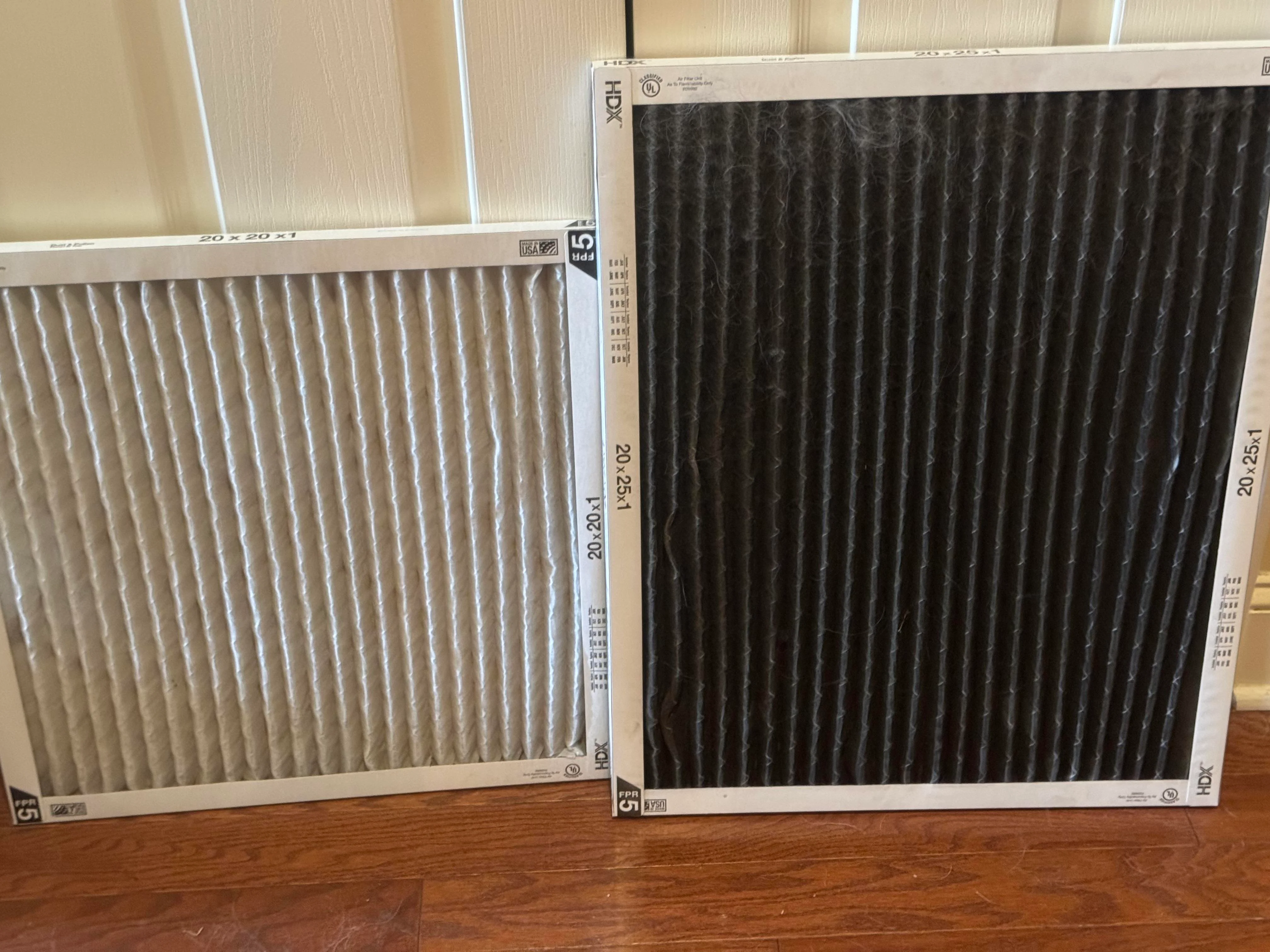Why is My Air Filter Black? An NJ Tech Explains
November 11, 2024

If you’ve recently changed out your air filter and noticed it was black, you’re experiencing something called “black soot deposition.
Essentially, black soot deposition is just an excess build-up of soot, which is typically the result of:
- A gas appliance or fireplace that isn’t burning fuel properly
- Scented candles
Over time, soot can build up in your air filter and on your walls, curtains, carpet, etc. While this black dust is annoying to clean, it can also cause major health problems. According to the American Lung Association (ALA), if you breathe in enough soot particles, you could end up with lung and respiratory diseases.
Now that you understand why your air filter is black (and the importance of ridding your home of excess soot), let’s look at a few reasons why you might have soot deposition in your home.
Black Air Filter Culprit #1: Scented candles
Have you ever burned a candle close to a wall or curtain and noticed a faint black stain after the candle was blown out? This is soot.
A lot of scented candles are made with unsaturated oils that don’t burn “clean,” resulting in soot residue.
If you notice that a candle flame is orange or yellow rather than a blue tint, it’s likely producing soot.
The most obvious solution is not to burn scented candles in your home. However, there are certain types of candles you can burn that don’t produce as much soot.
When looking for candles that don’t produce as much soot, look for:
- Candles without petroleum jelly or vegetable oil as an ingredient
- Candles that are hard to touch, not soft
In addition to the type of candle you buy, there are also a few things you can do to prevent soot in your home, like:
- Keep your candle wicks trimmed to ¼ inch
- Keep candles away from vents and fans
Black Air Filter Culprit #2: Gas Appliances
Unlike electric appliances, gas appliances actually have a burner flame.
If gas is not burning properly or there is an incorrect mixture of air and gas, it can cause your gas furnace or water heater to produce soot as a byproduct.
Just like with the candle, the best way to tell if your gas appliance is producing soot is to take a look at the color of the flame. If it's yellow or orange, it’s likely producing soot. You want the flame to be more of a blue color, as this indicates that the flame is burning “clean.”
For some appliances, like a gas stove, the flame should be visible when you turn the stove on. For other appliances, like a furnace, you’ll need to remove the furnace cover panel to see the color of the pilot light flame.
If you have a gas furnace and notice that the burner flame is yellow or orange, you should have a tech come evaluate:
- The heat exchanger- The heat exchanger could be cracked, which can allow combustion by-products (including soot) to enter your home’s air supply.
- Venting- Improper venting can trap exhaust and soot, forcing it into your home instead of releasing it outside.
- Burners- Misaligned or clogged burners can cause soot deposition.
- Gas valves - If gas valves are clogged with debris or dirt, it can cause soot to gather.
Note: If you notice that soot buildup is coming from your furnace, you need to call a tech ASAP. A cracked heat exchanger could leak carbon monoxide into your home, so it’s not a repair you want to sit on.
Additionally, if your furnace isn’t burning gas correctly, you could experience something called “flame rollout,” which is when the burner flame exceeds its confined area in search of oxygen. If your furnace is the soot-causing culprit, our suggestion would be to turn your furnace off and call a technician as soon as you can.
If you have a gas water heater and notice that the burner flame is yellow or orange, you should have a tech come look at:
- Burners- Just like with a furnace, if the burners are clogged or dirty, it can result in soot deposition.
- Flue pipe- The flue pipe is the part of your system that vents exhaust outside. If this pipe is clogged or blocked, your water heater won’t be able to get rid of the exhaust, which can cause soot buildup.
- Location of the system- If there is a lack of oxygen in the area, it could throw off the ratio of air to gas that’s needed to produce a clean flame.
Black Air Filter Culprit #3: Gas fireplace
If you have a gas fireplace, chances are this is what’s causing soot buildup in your home.
Unfortunately, gas fireplaces are usually engineered not to burn clean, because the yellow/orange flame is a more desirable color than a clean-burning flame, which is blue.
However, there are some measures you can take to lower the amount of soot buildup in your home due to a gas fireplace, like:
- Remove old or damaged logs
- Ensure logs are not in the pathway of flames
- Keep glass doors open when your fire is turned on
- Replace your air filter regularly
- Have a professional inspect the gas burner and pressure ever year
Still having issues with soot? Call an NJ pro!
If you’ve tried the above and are still having issues with soot, you should call a pro. As we mentioned above, soot is not only an annoyance but can cause serious health issues if it isn’t addressed.
We have 25 years of experience serving NJ homeowners, so we’d be happy to come check out your home and provide recommendations on how you can make sure your appliances are running efficiently (and soot-free).
